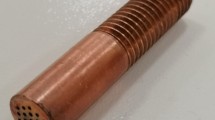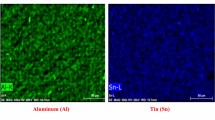Abstract
This paper seeks to improve the surface quality of electrical discharge machining (EDM) Ti–6Al–4V using plasma etching treatment and TiN coating. The EDM parameter setting is optimized firstly based on grey-Taguchi method. Four EDM parameters, including current (A), voltage (V), pulse duration (μs), and duty factor (%), are selected for multiple performance of lower electrode wear rate (EWR), higher material removal rate (MRR), and better surface roughness (SR). An orthogonal array, signal-to-noise (S/N) ratios, and analysis of variance (ANOVA) are used to analyze the effects of these EDM parameters. Normality tests show that all the distributions fit normality assumption with p = 0.276, 0.688, and 0.663, respectively. The EDM process is stable over time monitored by Shewhart control charts. It is observed that there is an EDM damaged layer on the surface consisting of debris, microcracks, molten drops, and solidified metals by scanning electron microscopy. The plasma etching and TiN coating are employed to improve surface quality of the EDMed Ti–6Al–4V alloys. The results demonstrate that using the oxygen plasma etching treatment, the damaged phenomena are decreased, and the mean SR value is reduced from Ra = 2.91 to Ra = 2.50 μm. In addition, when the plasma-treated alloy is coated with Ti buffer/TiN coating by physical vapor deposition, the surface morphology exhibits less defects and a better surface finish. The mean SR values are further reduced from Ra = 2.50 μm to Ra = 1.48 μm (for 740 nm TiN film) and Ra = 0.61 μm (for 1450 nm TiN film), respectively.
Similar content being viewed by others
References
Mower TM (2014) Degradation of titanium 6Al–4V fatigue strength due to electrical discharge machining. Int J Fatigue 64:84–96
Majorell A, Srivatsa S, Picu RC (2002) Mechanical behavior of Ti–6Al–4V at high and moderate temperatures-part I: experimental results. Mater Sci Eng A 326:297–305
Niinomi M (2008) Mechanical biocompatibilities of titanium alloys for biomedical applications. J Mech Behav Biomed Mater 1(1):30–42
Strasky J, Janecek M, Harcuba P, Bukovina M, Wagner L (2011) The effect of microstructure on fatigue performance of Ti–6Al–4V alloy after EDM surface treatment for application in orthopaedics. J Mech Behav Biomed Mater 4:1955–1962
Fonda P, Wang Z, Yamazaki K, Akutsu Y (2008) A fundamental study on Ti–6Al–4V’s thermal and electrical properties and their relation to EDM productivity. J Mater Process Technol 202:583–589
Hascalık A, Caydas U (2007) A comparative study of surface integrity of Ti–6Al–4V alloy machined by EDM and AECG. J Mater Process Technol 190:173–180
Dhananchezian M, Kumar MP (2011) Cryogenic turning of the Ti–6Al–4V alloy with modified cutting tool inserts. Cryogenics 51:34–40
Lin YC, Chen YF, Wang DA, Lee HS (2009) Optimization of machining parameters in magnetic force assisted EDM based on Taguchi method. J Mater Process Technol 209:3374–3383
Chiang YM, Hsieh HH (2009) The use of the Taguchi method with grey relational analysis to optimize the thin-film sputtering process with multiple quality characteristic in color filter manufacturing. Comput Ind Eng 56:648–661
Yang WJ, Hsu CY, Liu YW, Hsu RQ, Lu TW, Hu CC (2012) The structure and photocatalytic activity of TiO2 thin films deposited by dc magnetron sputtering. Superlattice Microst 52:1131–1142
Lin CL, Lin JL, Ko TC (2002) Optimisation of the EDM process based on the orthogonal array with fuzzy logic and grey relational analysis method. Int J Adv Manuf Technol 19:271–277
Chiou AH, Tsao CC, Hsu CY (2015) A study of the machining characteristics of micro EDM milling and its improvement by electrode coating. Int J Adv Manuf Technol 78:1857–1864
Kao JY, Tsao CC, Wang SS, Hsu CY (2010) Optimization of the EDM parameters on machining Ti–6Al–4V with multiple quality characteristics. Int J Adv Manuf Technol 47:395–402
Yang SF, Yeh JT (2011) Using cause selecting control charts to monitor dependent process stages with attributes data. Expert Syst Appl 38:667–672
Yang SF, Chen WY (2011) Monitoring and diagnosing dependent process steps using VSI control charts. J Stat Plan Infer 141:1808–1816
Huang CJ, Tai SH, Lu SL (2014) Measuring the performance improvement of a double generally weighted moving average control chart. Expert Syst Appl 41:3313–3322
Yan BH, Tsai HC, Huang Y (2005) The effect in EDM of a dielectric of a urea solution in water on modifying the surface of titanium. Int J Mach Tools Manuf 45:194–200
Guu YH, Hocheng H (2001) Improvement of fatigue life of electrical discharge machined AISI D2 tool steel by TiN coating. Mater Sci Eng A 318:155–162
Chen F, Zhu K, Chen A, Huang W, Feng L, Zhou Z, Ge G (2013) A Monte Carlo simulation model for surface evolution by plasma etching. Appl Surf Sci 280:655–659
Tendero C, Tixier C, Tristant P, Desmaison J, Leprince P (2006) Atmospheric pressure plasmas: a review. Spectrochim Acta B 61:2–30
Hascalık A, Caydas U (2007) Electrical discharge machining of titanium alloy (Ti–6Al–4V). Appl Surf Sci 253:9007–9016
Sheu SH, Tai SH, Hsieh YT, Lin TC (2009) Monitoring process mean and variability with generally weighted moving average control charts. Comput Ind Eng 57:401–407
Crowder SV (1987) Computation of ARL for combined individual measurement and moving range charts. J Qual Technol 19:98–102
Tserepi A, Gogolides E, Constantoudis V, Cordoyiannis G, Raptis I, Valamontes ES (2003) Surface roughness induced by plasma etching of Si-containing polymers. J Adhes Sci Technol 17(8):1083–1091
Cizek J, Kovarik O, Siegl J, Khor KA, Dlouhy I (2013) Influence of plasma and cold spray deposited Ti layers on high-cycle fatigue properties of Ti6Al4V substrates. Surf Coat Technol 217:23–33
Zhang XC, Xu BS, Xuan FZ, Tu ST, Wang HD, Wu YX (2008) Rolling contact fatigue behavior of plasma-sprayed CrC–NiCr cermet coatings. Wear 265:1875–1883
Author information
Authors and Affiliations
Corresponding author
Rights and permissions
About this article
Cite this article
Hsu, HY., Hu, CC. Surface quality improvement of EDMed Ti–6Al–4V alloy using plasma etching and TiN coating. Int J Adv Manuf Technol 88, 67–74 (2017). https://doi.org/10.1007/s00170-016-8760-8
Received:
Accepted:
Published:
Issue Date:
DOI: https://doi.org/10.1007/s00170-016-8760-8




